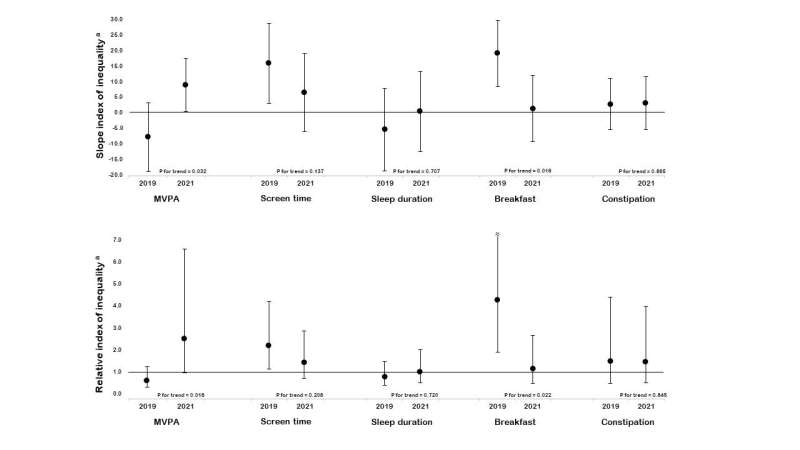This article has been reviewed according to Science X's editorial process and policies. Editors have highlighted the following attributes while ensuring the content's credibility:
fact-checked
peer-reviewed publication
trusted source
proofread
Study examines COVID-19's impact on socioeconomic inequality in health behaviors among Japanese adolescents

A study, led by Assistant Professor Kyan Akira (Kyoto University and Kobe University) and Professor Takakura Minoru (University of the Ryukyus), found for the first time that the socioeconomic inequality in achieving recommended physical activity levels among Japanese youth increased, while difference in breakfast intake decreased, during the COVID-19 pandemic compared to levels before the pandemic. The paper is published in the Journal of Physical Activity and Health.
The research team has previously identified socioeconomic inequality in physical activity among Japanese adults during the COVID-19 pandemic. This study focused on the issue of socioeconomic disparities in adolescent health behavior.
Health inequality in Japan has been moderate compared to Western countries, but the situation has worsened recently, pushing the government to take action since 2013. The disparities in health behaviors observed in Western countries are based on the economic status of households and neighborhoods, but the situation in Japan is not well understood because such inequality has only recently begun to attract attention in Japan.
During the COVID-19 pandemic, adolescent health behaviors deteriorated worldwide. National studies in Japan have also shown worsening health behaviors, including a marked decrease in physical activity and an increase in screen time. Researchers have also pointed out the possibility that the pandemic may exacerbate health disparities by increasing household income inequality.
This study aimed to identify trends in socioeconomic disparities in the health behaviors of Japanese adolescents before and during the COVID-19 pandemic, particularly in basic health behaviors, including physical activity, screen time, breakfast intake, and bowel movement frequency. The hope is that understanding these disparities will lead to developing intervention strategies and policies to provide youth with needed support.
Study summary
The study used data from the 2019 and 2021 National Sports-Life Survey of Children and Young People conducted by the Sasakawa Sports Foundation. The survey focuses on children and youth's after-school and weekend exercise and sports participation, sports environments, and health behaviors such as sleep duration, media usage time, and bowel movement frequency.
Data were collected from June to July each survey year using self-administered questionnaires from adolescents and their parents/guardians. Survey participants were selected using a two-staged stratified random sampling method from 225 sites proportionally distributed from the strata by district and city size based on the population of the Basic Resident Registers. The survey included 3,000 individuals aged four to 21.
The study's analysis included adolescents aged 12–18 and excluded 18-year-olds who did not attend high school. The number of participants who met the inclusion criteria for age and school enrollment was 1,076 for 2019 and 1,025 for 2021. After excluding individuals with missing variables, the research team analyzed data for 766 and 725 individuals in 2019 and 2021.
The research team used equivalent household income as a measure of socioeconomic status. In accordance with accepted health guidelines, favorable health behaviors were defined as daily moderate to vigorous physical activity (MVPA) of at least 60 minutes, screen time (ST) of less than two hours, sleep of eight to 10 hours, daily breakfast intake, and bowel movement frequency of at least once in every three days.
This study is unique in that it used slope and relative indices of inequality to account for differences in the percentage of the population in each category of socioeconomic factor (in this study, income).
The analysis found widening socioeconomic inequality among Japanese adolescents in achieving recommended physical activity levels before and during the pandemic, alongside narrowing inequality in breakfast intake. Specifically, despite no observed differences in physical activity by income in 2019, by 2021, adolescents from families with lower equivalent household incomes were less likely to engage in physical activity.
There was a trend toward a narrowing gap for screen time, but it was not statistically significant. No socioeconomic disparities were observed for sleep duration and defecation frequency in both 2019 and 2021.
Continued monitoring is needed to determine whether measures to promote physical activity before the COVID-19 pandemic also contributed to the reduction of widening socioeconomic disparities. The fact that this study revealed differences in physical activity among adolescents depending on their socioeconomic status underpins the importance of continued health (and health behavior) monitoring. This study promises to serve as a reference for considering policy directions.
More information: Akira Kyan et al, Impact of the COVID-19 Pandemic on the Socioeconomic Inequality of Health Behavior Among Japanese Adolescents: A 2-Year Repeated Cross-Sectional Survey, Journal of Physical Activity and Health (2023). DOI: 10.1123/jpah.2022-0489

















